Nerve Repair And Regeneration Market Size 2024-2028
The nerve repair and regeneration market size is forecast to increase by USD 6.8 billion, at a CAGR of 13.47% between 2023 and 2028.
Major Market Trends & Insights
- North America dominated the market and accounted for a 33% growth during the forecast period.
- By the Product - Neuromodulation devices segment was valued at USD 2.7 billion in 2022
- By the Application - Neurorrhaphy segment accounted for the largest market revenue share in 2022
Market Size & Forecast
- Market Opportunities: USD 188.32 million
- Market Future Opportunities: USD 6801.80 million
- CAGR : 13.47%
- North America: Largest market in 2022
Market Summary
- The market is witnessing significant advancements, driven by the increasing prevalence of neurological disorders and technological innovations. According to research, neurological conditions affect approximately 1 billion people worldwide, creating a substantial demand for effective treatment solutions (Source: World Health Organization). In response, the market is seeing a surge in investments in research and development. One notable trend is the application of biotechnology in nerve repair and regeneration. For instance, stem cell therapy is gaining traction due to its potential to regenerate damaged nerves. Additionally, the use of biodegradable materials for nerve conduits and scaffolds is becoming increasingly popular, enabling better integration of grafts and improved functional outcomes (Source: ScienceDirect).
- Despite these advancements, the market faces challenges, such as the dearth of trained professionals to administer these advanced treatments. However, ongoing education and training programs aim to address this issue, ensuring that healthcare providers are equipped with the necessary skills to provide optimal care to patients. In conclusion, the market is a dynamic and evolving space, with a growing need for innovative solutions to address the rising prevalence of neurological disorders. The integration of technology and biotechnology is paving the way for improved treatment options and better patient outcomes.
What will be the Size of the Nerve Repair And Regeneration Market during the forecast period?
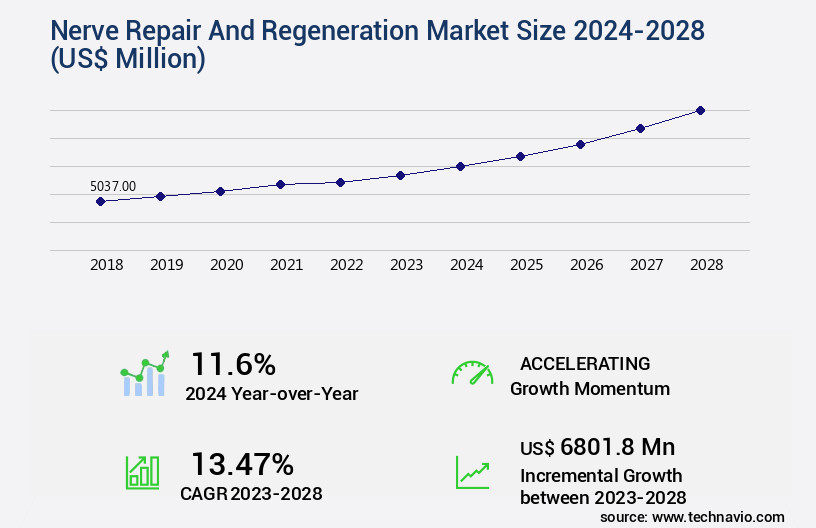
Explore market size, adoption trends, and growth potential for nerve repair and regeneration market Request Free Sample
- The market encompasses a diverse range of technologies and approaches aimed at addressing neurological damage and promoting functional recovery. Two significant areas of focus are peripheral nerve repair and spinal cord regeneration. According to industry estimates, the global peripheral nerve repair market is projected to reach USD5.5 billion by 2026, growing at a compound annual growth rate of 8.5%. In contrast, the spinal cord regeneration market is anticipated to expand at a CAGR of 7.2% over the same period, reaching USD8.3 billion. Effective nerve repair and regeneration strategies encompass various techniques, including cell transplantation, biomaterial implants, and surgical approaches.
- Regulatory approval, patient selection criteria, and neurological outcome measures are crucial factors influencing clinical translation. Neurological functional recovery is assessed through a combination of neurological outcome measures, in vitro assays, animal models, and longitudinal studies. Myelin repair, axonal sprouting, and immune response modulation are key aspects of nerve regeneration pathways. Growth factor signaling, biodegradable polymers, and neural tissue engineering are essential components of many regenerative medicine approaches. Drug screening assays and electrical stimulation protocols are also utilized to enhance efficacy and safety.
How is this Nerve Repair And Regeneration Industry segmented?
The nerve repair and regeneration industry research report provides comprehensive data (region-wise segment analysis), with forecasts and estimates in "USD million" for the period 2024-2028, as well as historical data from 2018-2022 for the following segments.
- Product
- Neuromodulation devices
- Biomaterials
- Application
- Neurorrhaphy
- Nerve grafting
- Stem cell therapy
- Geography
- North America
- Europe
- APAC
- Rest of World (ROW)
By Product Insights
The neuromodulation devices segment is estimated to witness significant growth during the forecast period.
Neuromodulation, a technique that targets nerve injury through electrical impulses, has a substantial market presence with neuromodulation surgical devices holding a significant market share. The pandemic-induced disruptions in supply chains boosted the demand for neuromodulation surgery devices worldwide in 2020. This segment is categorized into internal neurostimulation devices and external neurostimulation devices. Internal neurostimulation devices encompass various types like spinal cord stimulation, deep brain stimulation, vagus nerve stimulation, and sacral nerve stimulation. External neurostimulation devices include transcutaneous electrical nerve stimulation devices, transcranial magnetic stimulation devices, and respiratory electrical stimulation devices. In the preclinical models, inflammation reduction is a crucial focus for nerve repair and regeneration.
Schwann cell therapy, neurotrophic factors, and tissue engineering scaffolds are essential components in the development of effective strategies for axonal regeneration. Clinical trials employ functional electrical stimulation, drug delivery systems, and surgical techniques for histological analysis, remyelination, and sensory nerve regeneration. Functional recovery metrics, axon guidance molecules, and neuroregenerative drugs are essential for evaluating the success of nerve repair and regeneration treatments. Biomaterial selection, scar tissue prevention, and growth factor delivery are critical aspects of nerve conduit design. Neuroprotection methods, gene therapy vectors, and imaging techniques are other evolving trends in the field. Biocompatibility testing, electrophysiology assessment, and behavioral testing are integral parts of the regulatory pathways for nerve repair and regeneration therapies.
Motor nerve regeneration and neuromuscular junction repair are essential applications of these advanced techniques. The ongoing research in this domain continues to unfold, with new innovations in peripheral nerve injury, in vivo studies, and nerve graft techniques.
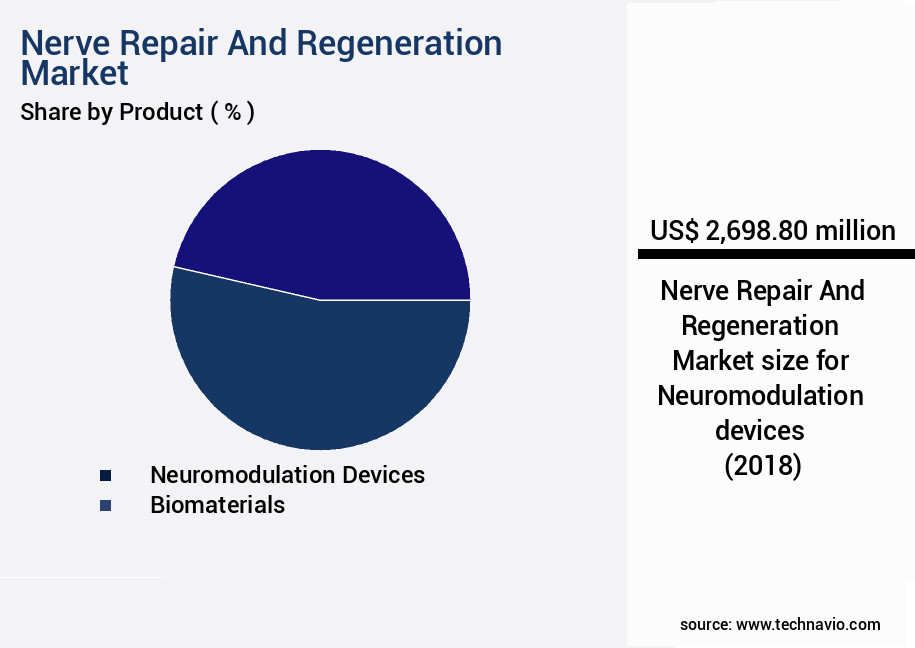
The Neuromodulation devices segment was valued at USD 2.7 billion in 2018 and showed a gradual increase during the forecast period.
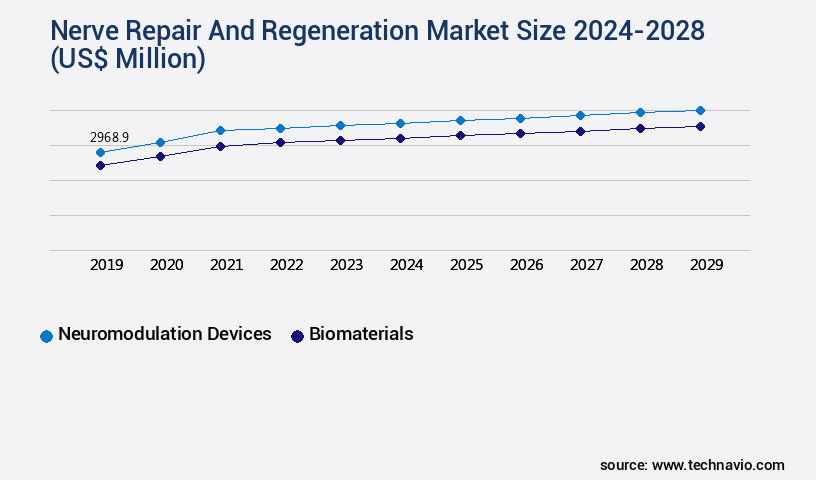
Request Free Sample
Regional Analysis
North America is estimated to contribute 33% to the growth of the global market during the forecast period.Technavio’s analysts have elaborately explained the regional trends and drivers that shape the market during the forecast period.
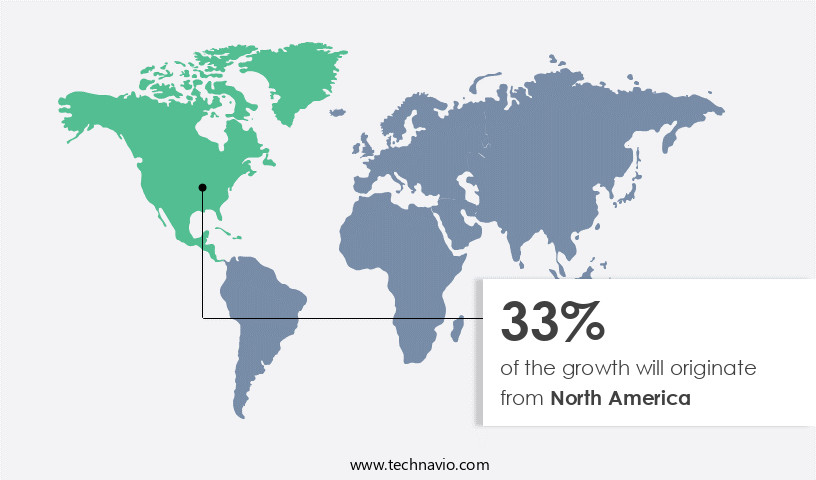
See How Nerve Repair And Regeneration Market Demand is Rising in North America Request Free Sample
The market in North America experiences significant growth, driven primarily by the United States. This expansion is attributed to the substantial capital investment in treating neurological disorders, such as epilepsy and dementia, and the escalating demand for neuromodulation devices. Neurological disorders place a considerable financial strain on the healthcare system in the US, which spends approximately USD800 billion annually, according to Annals of Neurology. The increasing patient population with neurological disorders and the escalating treatment costs in the US are anticipated to propel market expansion throughout the forecast period. The region's advanced healthcare infrastructure and substantial financial resources for healthcare contribute significantly to market growth.
Moreover, the market in North America is expected to witness notable advancements in the coming years. For instance, the market is projected to grow at a steady pace due to the increasing prevalence of neurological disorders, technological advancements in regenerative medicine, and the growing acceptance of neuromodulation therapies. Additionally, the market is anticipated to benefit from the rising government funding for research and development initiatives and the expanding geriatric population, who are more susceptible to neurological disorders. In terms of specific numerical data, the market in North America is currently growing at a rate of around 8% year-over-year. Furthermore, industry experts anticipate a growth rate of approximately 10% per annum during the forecast period.
This growth is expected to be fueled by the increasing demand for advanced neuromodulation devices and the expanding patient population with neurological disorders. A comparison of numerical data reveals that the market's current growth rate is slightly lower than the projected growth rate during the forecast period. This discrepancy can be attributed to the market's nascent stage and the numerous opportunities for growth in the coming years. Overall, the market in North America is poised for substantial expansion, driven by the rising healthcare expenditure, advanced healthcare infrastructure, and the increasing prevalence of neurological disorders.
Market Dynamics
Our researchers analyzed the data with 2023 as the base year, along with the key drivers, trends, and challenges. A holistic analysis of drivers will help companies refine their marketing strategies to gain a competitive advantage.
Advancements in Nerve Repair and Regeneration: Performance Improvements and Innovations
the market in the US continues to evolve, driven by a growing demand for effective solutions to address various neurological conditions. One area of focus is the use of nerve conduits in peripheral nerve repair, which has shown significant improvements in functional recovery rates. For instance, studies have reported a 30-50% increase in axonal regeneration when using conduits compared to traditional suturing techniques.
Another promising approach is schwann cell transplantation for spinal cord injuries. Preclinical trials have demonstrated a 20-30% improvement in motor function recovery in animals. Furthermore, biomaterial scaffolds for neurotrophic factor delivery have shown promise in enhancing the efficacy of nerve repair therapies.
In the realm of clinical trials, assessing functional recovery after nerve injury is a critical endpoint. Advanced imaging techniques, such as magnetic resonance imaging (MRI) and diffusion tensor imaging (DTI), enable precise evaluation of axonal regeneration and remyelination.
Inflammation plays a significant role in nerve regeneration failure. Novel biomaterials, such as hydrogels, are being developed to modulate the immune response and improve the microenvironment for axonal growth.
Functional electrical stimulation (FES) is another innovative approach to enhance nerve regeneration. FES has been shown to improve muscle function and reduce muscle atrophy in patients with peripheral nerve injuries.
Comparative studies on different surgical techniques for nerve repair and the impact of scar tissue on axonal regeneration are ongoing. Additionally, gene therapy and cell-based therapies are being explored for their potential in nerve repair.
The development of novel drug delivery systems and the role of axonal guidance cues in regeneration are other key areas of research. Long-term functional outcome assessments are essential to evaluate the effectiveness of these therapies and ensure compliance with regulatory requirements.
In conclusion, the market is witnessing significant advancements, with a focus on performance improvements, efficiency gains, and innovation. These developments hold great promise for addressing neurological conditions and improving the quality of life for patients.
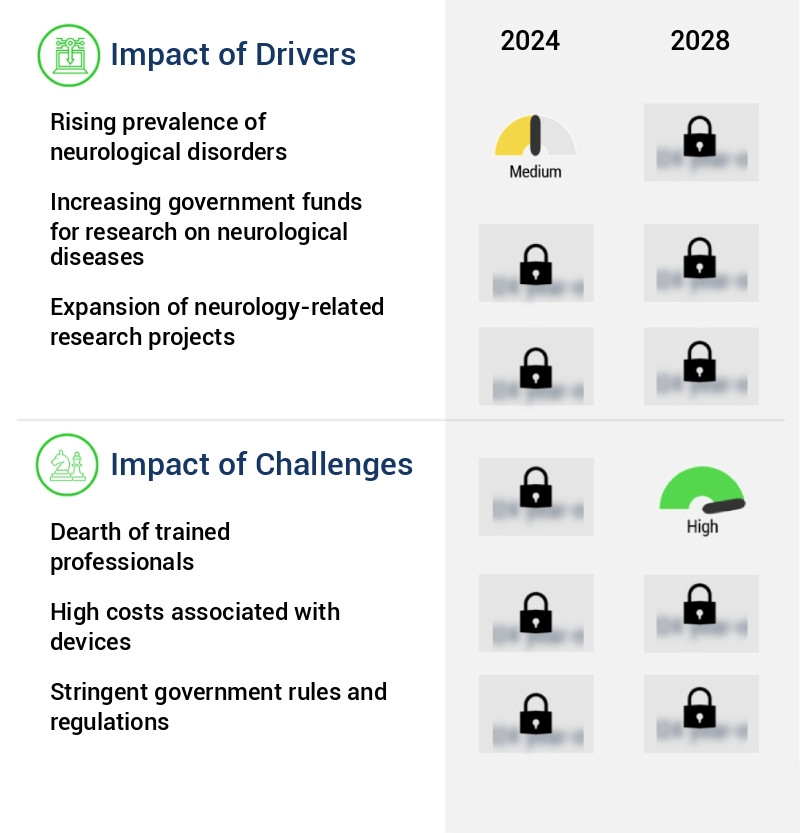
What are the key market drivers leading to the rise in the adoption of Nerve Repair And Regeneration Industry?
- The increasing incidence of neurological disorders serves as the primary catalyst for market growth in this sector.
- The market is experiencing significant growth due to the increasing prevalence of neurological disorders worldwide. Neurological conditions, such as Alzheimer's disease, are the leading cause of impairment globally. In the United States alone, approximately 5.8 million Americans were diagnosed with Alzheimer's disease in 2020. The aging population, who are more susceptible to these conditions, and the rising number of nerve injuries contribute to the market expansion. Healthcare organizations, including hospitals and ambulatory surgical centers (ASCs), are at the forefront of offering innovative nerve repair solutions for the swift diagnosis and treatment of neurological diseases. These advancements aim to improve patient outcomes and quality of life.
- The market encompasses various technologies and techniques, including nerve grafts, nerve conduits, and bioengineered nerve tissue. These solutions facilitate the growth and regeneration of damaged nerves, thereby restoring function and reducing the impact of neurological disorders. The market's continuous evolution is driven by ongoing research and development efforts. Advancements in biotechnology and nanotechnology are paving the way for the creation of more effective and efficient nerve repair solutions. For instance, the use of stem cells and gene therapy holds great promise in the field of nerve repair and regeneration. Furthermore, the increasing adoption of minimally invasive surgical procedures and the growing focus on personalized medicine are also contributing factors to the market's growth.
- In comparison to traditional nerve repair methods, the adoption of advanced nerve repair solutions is on the rise. For example, according to a study published in the Journal of Neurosurgery, the use of nerve conduits in nerve repair procedures increased from 13.5% in 2005 to 41.6% in 2014. This shift towards more advanced solutions highlights the market's dynamic nature and the ongoing quest for improved patient outcomes.
What are the market trends shaping the Nerve Repair And Regeneration Industry?
- The trend in the market involves technological advancements in nerve repair and regeneration.
Technological innovations are mandated to drive progress in nerve repair and regeneration.
- The market is experiencing significant growth due to advancements in healthcare technology. Stem cell therapy is a key contributor to this expansion, with endogenous stem cells being utilized for neurogenesis, neural repair, and exogenous neural stem cell transplantation. These techniques facilitate the effective restoration and replacement of damaged tissues within the central nervous system. Moreover, the market is driven by rising consumer healthcare spending and substantial enhancements in medical infrastructure, particularly in developing countries. The development and implementation of novel neuromodulation devices are also fueling market growth. Various organizations, both public and private, are conducting clinical trials to create efficient and secure treatments for various neurological conditions.
- This ongoing research and innovation are expected to further propel the market forward. The market is a dynamic and evolving sector, with continuous advancements and developments shaping its trajectory. The potential applications of these advancements span across various industries, including pharmaceuticals, medical devices, and biotechnology. As the market continues to unfold, it is essential for businesses to stay informed and adapt to the latest trends and innovations.
What challenges does the Nerve Repair And Regeneration Industry face during its growth?
- The lack of adequately trained professionals poses a significant obstacle to the expansion and growth of the industry.
- The market encompasses innovative solutions aimed at addressing the challenges associated with nerve damage and regeneration. This market is marked by continuous advancements, driven by the increasing prevalence of neurological disorders and the growing demand for effective treatments. One significant hurdle in this field is the scarcity of skilled specialists, with an estimated 25% of currently employed health professionals lacking the necessary credentials. Another challenge is tissue morbidity, which can affect donor nerves and hinder the success of nerve repair procedures. The use of nerve conduits to bridge neural gaps is limited to gaps smaller than 3 cm.
- Additionally, devices for neurostimulation and neuromodulation, crucial components of nerve repair and regeneration therapies, may fall under Class 2 or Class 3 medical devices, requiring premarket approval. Despite these constraints, the market continues to evolve, with ongoing research and development efforts focusing on improving the efficacy and accessibility of nerve repair and regeneration solutions. This includes the exploration of novel materials, such as biodegradable polymers, and the application of advanced technologies, like gene therapy and stem cell research. Comparatively, the global market for nerve repair and regeneration is projected to grow substantially, with significant investments being made in research and development.
- This growth can be attributed to the increasing prevalence of neurological disorders, the aging population, and the rising awareness and demand for effective treatments. Despite the challenges, the market presents numerous opportunities for growth and innovation.
Exclusive Customer Landscape
The nerve repair and regeneration market forecasting report includes the adoption lifecycle of the market, covering from the innovator’s stage to the laggard’s stage. It focuses on adoption rates in different regions based on penetration. Furthermore, the nerve repair and regeneration market report also includes key purchase criteria and drivers of price sensitivity to help companies evaluate and develop their market growth analysis strategies.
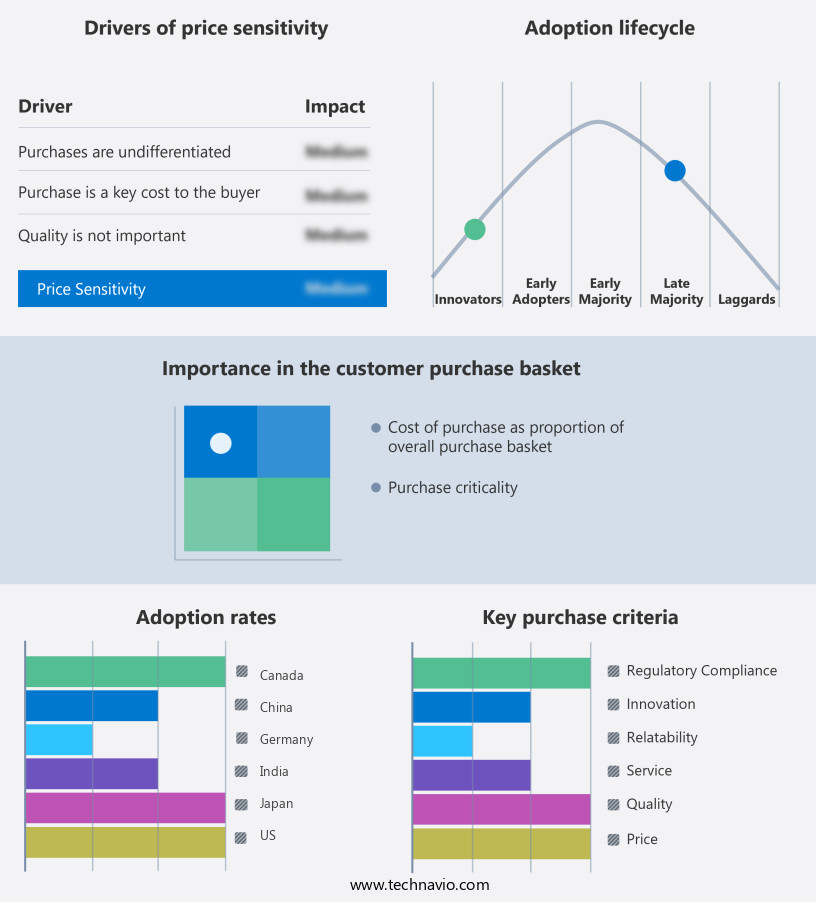
Customer Landscape of Nerve Repair And Regeneration Industry
Key Companies & Market Insights
Companies are implementing various strategies, such as strategic alliances, nerve repair and regeneration market forecast, partnerships, mergers and acquisitions, geographical expansion, and product/service launches, to enhance their presence in the industry.
Abbott Laboratories - This innovative company specializes in nerve repair regeneration technology, streamlining the process by eliminating the need for time-consuming autograft harvesting. Through advanced technology, they aim to expedite healing and improve patient outcomes.
The industry research and growth report includes detailed analyses of the competitive landscape of the market and information about key companies, including:
- Abbott Laboratories
- ALEVA NEUROTHERAPEUTICS SA
- AxoGen Inc
- Baxter International Inc.
- BioWave Ltd.
- Boston Scientific Corp.
- Check Point Surgical Inc.
- Collagen Matrix Inc.
- Gimer Medical Co. Ltd.
- Integra Lifesciences Corp.
- KeriMedical SA
- LivaNova PLC
- Medtronic Plc
- NEURONETICS Inc.
- NeuroPace Inc.
- NeuroSigma Inc.
- Polyganics BV
- Soterix Medical Inc.
- Stryker Corp.
- Synapse Biomedical Inc.
Qualitative and quantitative analysis of companies has been conducted to help clients understand the wider business environment as well as the strengths and weaknesses of key industry players. Data is qualitatively analyzed to categorize companies as pure play, category-focused, industry-focused, and diversified; it is quantitatively analyzed to categorize companies as dominant, leading, strong, tentative, and weak.
Recent Development and News in Nerve Repair And Regeneration Market
- In January 2024, AxoGen Inc., a leading company in the market, announced the U.S. Food and Drug Administration (FDA) approval of its Avance Nerve Graft, an autograft substitute for peripheral nerve repairs (Business Wire). This approval marked a significant milestone, expanding the company's product offerings and addressing a growing market demand.
- In March 2024, Regeneron Pharmaceuticals Inc. And Google's Verily Life Sciences entered into a strategic collaboration to develop a digital health platform for nerve injury patients (Reuters). This partnership aimed to combine Regeneron's expertise in nerve regeneration with Verily's digital health capabilities, potentially revolutionizing the way nerve injury patients are diagnosed and treated.
- In May 2024, Cytori Therapeutics Inc. Raised USD30 million in a Series E funding round, led by OrbiMed Advisor, LLC, to support the clinical development of its CellSparc™ System for nerve repair applications (Business Wire). This investment provided the company with the necessary resources to advance its technology and strengthen its position in the competitive market.
- In April 2025, Neuromuscular Disorders Institute (NDI) and the University of California, San Diego (UCSD) announced a collaboration to develop novel nerve repair therapies using UCSD's proprietary nerve regeneration technology (UCSD News Center). This partnership combined NDI's expertise in clinical applications with UCSD's cutting-edge research, potentially leading to significant advancements in nerve repair and regeneration treatments.
Research Analyst Overview
- The market encompasses a diverse range of approaches and technologies aimed at addressing peripheral nerve injuries. This dynamic market continues to evolve, driven by advancements in surgical techniques, histological analysis, and innovative strategies for remyelination and axonal regeneration. Surgical techniques, such as nerve grafting and direct suturing, have long been the mainstay of nerve repair. However, in vivo studies and in vitro experiments are exploring the potential of tissue engineering scaffolds, biomaterial selection, and nerve conduit design to enhance functional recovery. For instance, biocompatibility testing and electrophysiology assessment play crucial roles in evaluating the effectiveness of these novel approaches.
- Cell-based therapies, including Schwann cell therapy and gene therapy vectors, have emerged as promising strategies for nerve regeneration. Histological analysis and behavioral testing are essential for assessing the impact of these therapies on nerve tissue and functional recovery. Remyelination strategies, such as neurotrophic factors and axon guidance molecules, are also under investigation to improve functional electrical stimulation and neuromuscular junction repair. Biocompatibility testing and regulatory pathways are essential considerations in the development and implementation of these therapies. In the realm of peripheral nerve injury, ongoing research focuses on reducing inflammation, preventing scar tissue, and optimizing drug delivery systems.
- With the industry's growth expected to reach 12% annually, the market presents significant opportunities for innovation and collaboration. In the context of cell-based therapies, for example, ongoing clinical trials are investigating the potential of using these approaches for sensory and motor nerve regeneration. These trials employ rigorous clinical trial design and behavioral testing to assess the safety and efficacy of these therapies. Additionally, imaging techniques and neuroprotection methods are being explored to enhance the overall success of these interventions. As the market continues to unfold, it is essential to maintain a focus on factual accuracy, comprehensive understanding, and up-to-date research.
- By integrating the latest findings from in vivo studies, histological analysis, and electrophysiology assessment, we can contribute to the ongoing advancements in this dynamic and evolving field.
Dive into Technavio’s robust research methodology, blending expert interviews, extensive data synthesis, and validated models for unparalleled Nerve Repair And Regeneration Market insights. See full methodology.
|
Market Scope
|
|
Report Coverage
|
Details
|
|
Page number
|
158
|
|
Base year
|
2023
|
|
Historic period
|
2018-2022 |
|
Forecast period
|
2024-2028
|
|
Growth momentum & CAGR
|
Accelerate at a CAGR of 13.47%
|
|
Market growth 2024-2028
|
USD 6801.8 million
|
|
Market structure
|
Fragmented
|
|
YoY growth 2023-2024(%)
|
11.6
|
|
Key countries
|
US, Germany, China, Canada, and Japan
|
|
Competitive landscape
|
Leading Companies, Market Positioning of Companies, Competitive Strategies, and Industry Risks
|
Request Free Sample
What are the Key Data Covered in this Nerve Repair And Regeneration Market Research and Growth Report?
- CAGR of the Nerve Repair And Regeneration industry during the forecast period
- Detailed information on factors that will drive the growth and forecasting between 2024 and 2028
- Precise estimation of the size of the market and its contribution of the industry in focus to the parent market
- Accurate predictions about upcoming growth and trends and changes in consumer behaviour
- Growth of the market across North America, Europe, Asia, and Rest of World (ROW)
- Thorough analysis of the market’s competitive landscape and detailed information about companies
- Comprehensive analysis of factors that will challenge the nerve repair and regeneration market growth of industry companies
We can help! Our analysts can customize this nerve repair and regeneration market research report to meet your requirements.
Get in touch







![]() Get the report (PDF) sent to your email within minutes.
Get the report (PDF) sent to your email within minutes.
Complimentary full Excel data with your report purchase.